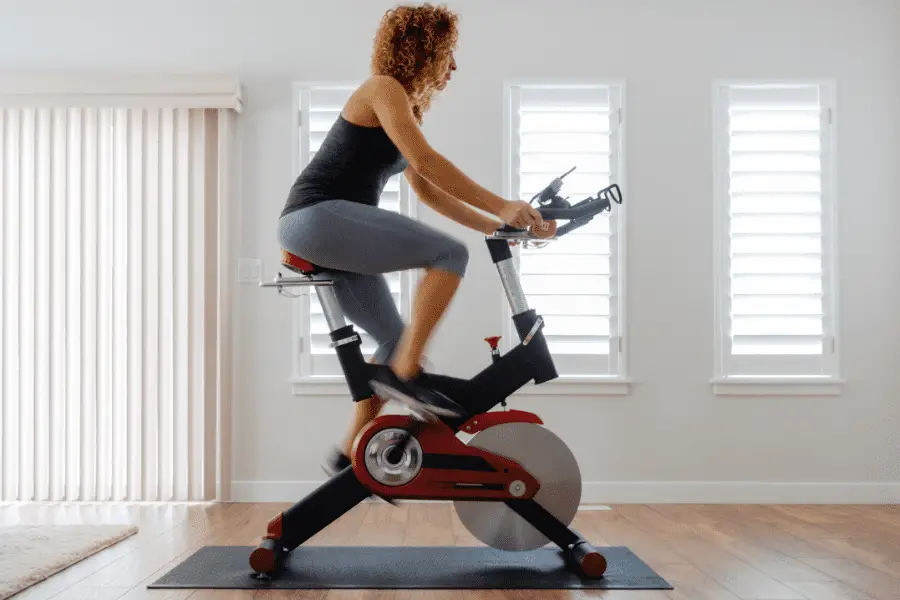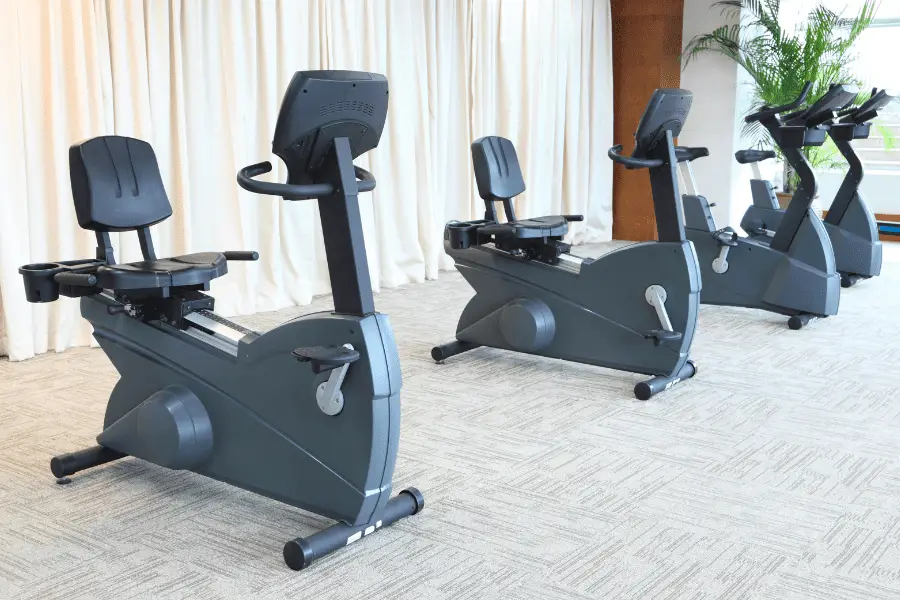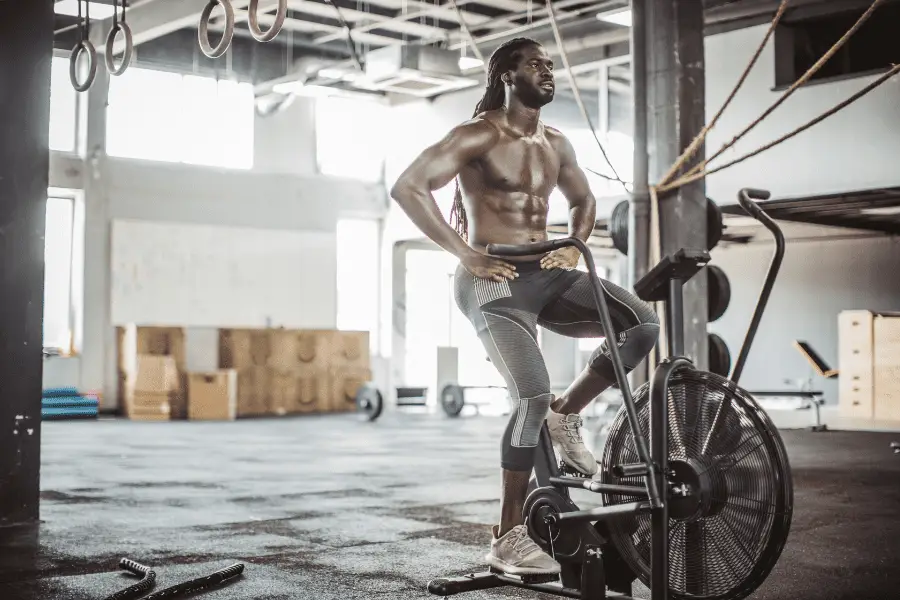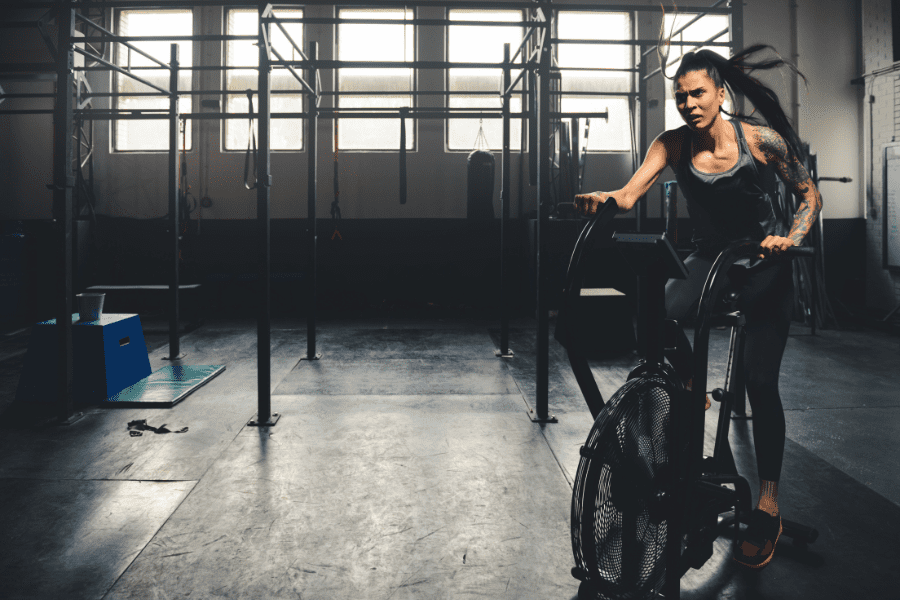Buying a stationary exercise bike can be a bit confusing. There are so many different types of stationary bike it can be hard to figure out which types exist and which is the best for you. Here’s what you want to know.
There are four main types of stationary exercise bikes; Spin, upright, air and recumbent. The main differences are the seating position and features. Resistance can be created by a brake pad, magnetic brake or fan blade. Some upright bikes have hand levers for a full body workout.
Find out what the differences are and what is right for your situation below.
Contents
Stationary Exercise Bike Designs
We can split up exercise bikes in four categories. Of course every different model bike looks different but there are a few main types that are significantly similar to each other to give them a name.
Design in this case means the layout of the bike. The layout has some effect on look but mainly on purpose, feel and different benefits. However, because they are meant to be used for different purposes and in different ways, the features and size also changes.
There are three different main layouts;
- Upright Stationary Bike
- Recumbent Stationary Bike
- Spin Stationary Bike
- Air/Fan Bike
There are no real rules for what distinguishes a type of bike but it’s largely decided by the seating position.
You could argue that the fan bike is a type of upright bike and not a separate class. They have an upright seating position but also have hand levers and look quite different from other upright bikes. In my opinion they’re different enough that they warrant a separate spot in the list.
Spin bike

Most people think about a spin bike when they hear stationary exercise bike. They are by no means the only type but they are very common. Spin bikes are the smallest and simplest exercise bikes. That doesn’t mean they are easy easy to work out on. Spin bikes can provide a very tough workout.
Spin bikes mimic a racing bicycle in seating position and purpose. The seat is small and usually quite hard. The seating position is very aggressive with the seat and handlebars at the same height. This means you’re really bent over. This allows you to stand up on the pedals and still put a lot of force into the pedals which is what makes the spin bike good for high intensity workouts.
Most spin bikes have a felt or leather brake pad that slows down the flywheel and so creates resistance. Some higher end models have magnetic resistance. Magnetic resistance is more consistent and requires less maintenance but it’s a bit more expensive.
Spin bikes are usually just a metal frame with pedals, flywheel, seat and handlebars. They’re simple but sturdy. There are no plastics and usually no or very little electronics. This makes spin bikes small and relatively light. That makes them pretty sturdy and light and you can get the basic models for relatively little money. All these things are why they’re very popular for spin classes but they’re also great as a compact exercise bike for at home.
Spin bike benefits:
- Good for high intensity workouts
- Compact
- Easy to move around
- Cheapest type of exercise bike in general
Upright
The most common type of exercise bike in most gyms (outside spin classes) is the upright bike. It gets its name from the seating position. The seating position is usually quite upright with the handlebars higher than the seat. Depending on how you set it up, you can still be a little bent over but not as much as on a spin bike. The pedals are under the seat making for an active seating position. The seat is usually quite small like on a road bike and standing on the pedals is possible.
These bikes usually have magnetic resistance. That means there is a metal flywheel and a magnet tries to stop it creating resistance. The resistance is set by a button on the console. Most upright bikes have a console with information about your workout. Some fancier models have big screens that can stream workouts or anything you want.
Suggested: Is 30 minutes on an exercise bike enough to see results?
Upright bikes are good for steady state cardio but also interval training. They’re a bit more relaxed than a spin bike and often have some plastic shrouding around them so they look quite different. They can be quite simple or have very fancy consoles or even a large screen.
Benefits of upright bikes:
- Good for low or high intensity training
- Available with very advanced features
- Magnetic resistance is very consistent and easy to adjust
- Smaller than recumbent bike but a little bigger than a spin bike.
The upright bike is best for people who want something a little more comfortable than a hardcore spin bike but still want to be able to do high intensity workouts. People that want more features than the average spin bike are good candidates for the upright style stationary bike.
Recumbent

At first sight, a recumbent bike might just look like an upright bike with a backrest. The differences go a bit further than that though. There are some pretty significant differences between an upright bike and a recumbent bike.
A recumbent bike has a much more relaxed seating position. Where you’re pretty bent over on an upright bike, you’re leaning back on a recumbent bike. In addition the pedals are further forward which means your legs aren’t as bent either. The seat is also much bigger and more comfortable than other stationary bikes.
On a recumbent bike it’s not necessary to hold any bars or levers, which means you’ll have your hands free most of the time. That makes a recumbent bike perfect for steady state, low intensity cardio. You can do many other things while on a recumbent bike. Reading a book, watching tv, etc. are all possible.
7 Things a recumbent bike can do for your body
Another benefit is that a recumbent bike is very easy on your back. Because you’re not bent over, you have a backrest and your legs aren’t as bent. Because the back and joints are in a much more neutral position, you’re stressing them less and they’ll feel better.
And finally most models are very easy to get on and off. The seat is quite a bit lower than on a spin or upright bike which makes it great for seniors or less mobile people.
Like upright bikes, most recumbent bikes will have magnetic resistance that’s adjustable with the simple touch of a button on the console. Just like upright bikes, recumbent bikes usually have pretty advanced consoles with a lot of buttons and big screens on the high end models.
Benefits of recumbent bikes;
- Wide, comfortable seat
- Backrest
- Comfortable seating position
- Great for people with back issues
- Easier to get on and off than spin/upright bikes
Air bike

The air bike is an interesting type of exercise bike. Instead of a flywheel, there is a big fan blade that creates resistance. The air resistance created by spinning the fan blade is what creates the resistance in the pedals. There are no buttons or adjustment knobs for the resistance because it all depends on the speed of the fan blade and thus on how fast you pedal. Air resistance is not linear but exponential. So if you want to pedal twice as fast, it doesn’t cost twice the effort but much more than that.
That means going hard on an air bike is incredibly tough. This makes it great for High Intensity Interval Training (HIIT). Another reason why fan bikes are tough is the hand levers. Instead of only pedals, there also are levers you pull/push with your hands. This means it becomes a full body workout that involves the upper body as well as the lower body. Combine this with the very high maximum resistance, you’ve got a very tough bike to work out on.
The seating position is quite upright and the seats are relatively comfortable so while an air bike is great for HIIT, it can also be used for steady state cardio. Most of these bikes don’t have many plastic shrouds and are relatively light so while they’re slightly bigger than a spin bike, they’re still quite compact and easily movable.
Air/Fan bike benefits:
- Very high maximum resistance
- Great for HIIT
- Full body workout
- Easy to move around
Stationary Bikes Resistance Types
There are three types of exercise bike resistance. The resistance type does have some impact on how the bike feels, how much it costs and the maintenance.
- Brake pad
- Magnetic
- Fan
Flywheel/brake
The most basic resistance type is the brake on a flywheel. It’s a very common system that is commonly found on the lower end models.
It works pretty much the same as the brakes on a bicycle. (unless you’ve got a fancy bicycle with disc brakes) Little pads rub on the flywheel which slows it down. To keep up the speed, you’ll have to push the pedals harder.
Instead of a brake lever like on a bicycle, you’ll have a rotary knob that adjusts the resistance.
This type of resistance is often seen on spin bikes. So the simplicity doesn’t means you can’t get a tough workout done.
The resistance might not feel as smooth as the other types especially if you’re pedaling slower. The weight and size of the flywheel also has an impact on the smoothness.
Also, like brake pads on a bicycle or car, they wear out and have to be replaced at certain times. This isn’t very often but something to keep in mind. This also means that a certain resistance setting doesn’t always feel the same. The more the brake pad wears, the more you’ll have to adjust the knob to get the same level of actual resistance.
Suggested: Can you lose belly fat by only using an exercise bike?
Magnetic
A magnetic resistance exercise is pretty similar to the simple brake setup, except the brake is magnetic. Instead of brake pads an electromagnet slows down the flywheel. This resistance is adjustable with the push of a button. The more current is sent through the magnet, the stronger the resistance.
The benefits of this type of resistance are;
- Smooth feeling
- Easily adjustable
- Always consistent
- Looks nicer
- Allows for different packaging
- Allows for information console
Magnetic resistance stationary bikes are often found in commercial gyms. Because the type of resistance also allows for manufacturers to easily add an information console that shows; speed, calories, time, etc.
They often look a bit more ‘dressed’ since there are plastics around the flywheel which makes it look a bit more substantial.
Air/fan

Instead of a flywheel, you’re driving a really big fan when you’re pedaling. This type of resistance is quiet and very smooth. Many models have a kind of clutch in between the pedals and fan so the fan keeps spinning if you stop pedaling for a moment. This makes it feel much more like riding a bike outside than the other resistance types.
Suggested post: Are air bikes noisy?
With air resistance, the faster you pedal, the more resistance you’ll feel. Some models also have a way to change the ratio of how fast the fan spins for every revolution of the pedals. Obviously, the more the fan spins for every revolution, the higher the starting resistance is.
Suggested post: Why are air bikes so hard to work out on?
As an added benefit, you create some airflow by pedaling that cools you down while working out.
Because the resistance is so flexible, fan bikes are amazing for High Intensity Interval Training (HIIT) This is a great way to burn more calories in a short period of time and also improve your cardiovascular health. A good interval timer is going to make HIIT workouts much more enjoyable. Check out the GymNext Flex timer. It’s super easy to set up and control contrary to most other interval timers making the set up for any workout a breeze.
Favorite Cardio Accessories
Check out these accessories that improve a home cardio workout:
- Equipment mat: All cardio equipment should be put on an equipment mat. The Rubber-Cal mat (Amazon) is an affordable yet very high-quality choice.
- Interval timer: To time your intervals and workouts, there is no better choice than the GymNext Flex. It’s super easy to use and set up with a phone app.
- Tablet holder: Cardio can be boring. With this tablet holder (Amazon) you can follow along with on-demand workouts or just watch a movie on any cardio machine.
- Heart rate monitor: Monitoring your heart rate is very important while doing cardio. The Polar H10 (Amazon) connects to almost anything you can imagine and is very accurate.
To find which cardio machines I recommend for home gyms, click here.

